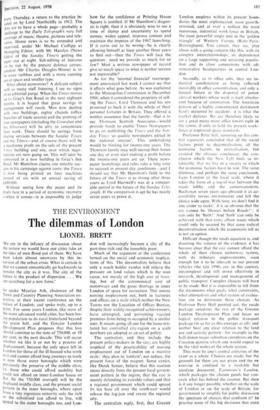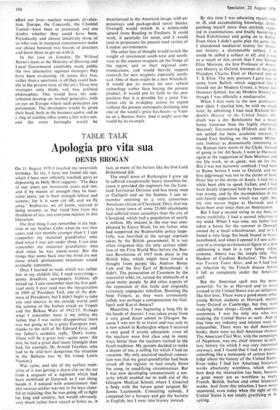THE ENVIRONMENT
The dilemmas of London
LIONEL BRETT
'We are in the infancy of discussion about the nature we would have our cities take as the tides of men flood out of them. We have been taken almost unawares by this in- version of the urban crisis. What is certain is that we cannot romantically go backwards to remake the city as it was. The city of the future is the product of dispersion . . . We are searching for a new form.'
So spoke Maurice Ash, chairman of the Town and Country Planning Association ex- ecutive, at their recent conference on the future of Londoii; and spoke truly, up to a point. For some years London, like most of the more advanced world cities, has been los- ing population to its rural hinterland beyond the green belt, and the Greater London Development Plan proposes that this loss should continue to the tune of 750,000, or 10 per cent, in the next decade. This will occur whether we like it or not by a process of displacement, because the only space left in London for those of the ill-housed who work in it and cannot afford long journeys to work is now those outer boroughs which were previously the preserve of the middle class, 1.e. those who could afford mobility but could not afford an inner-London house or flat. So the 750,000 overspill will be the displaced middle class, and the present social pattern in the inner boroughs, where apart from -a tiny ingenious minority only the rich or the subsidised can afford to live, will spread to the outer boroughs too, and Lon-
don will increasingly become a city of the part-time rich and the immobile poor.
Much of the argument at the conference turned on the social and economic implica- tions of this. The decentralists believe that only a much bolder exodus will relieve the pressure on land values which is the root cause, not merely of the high cost of hous- ing, but of the astronomical cost of motorways and the gross shortage in inner London of space for recreation. This means moving employment out, both in factories and offices, on a scale which neither the New Towns nor the Location of Offices Bureau, despite their widely recognised achievements, have attempted, and preventing vacated premises from being re-occupied by a similar user. It means going all out for the loose-tex- tured but controlled city-region on a scale nowhere yet adopted as an act of policy.
The centralists, and they include the present policy-makers in the otc, are highly sceptical of the practicability of moving employment out of London on a massive scale: they plan to 'contain', not reduce, the present force of the magnet. Some cynics, like 'Derek Senior, believe that this caution stems directly from the present local govern- ment pattern in the region, that the Giz is merely defending its rateable values and that a regional government which could spread its tax base all over the south-east would release the log-jam and create the regional city.
The centralists reply, first, that Greater London employs within its present boun- daries the most sophisticated, most growth- oriented, and at over a million the most numerous, industrial work-force in Britain, the most powerful single unit in the 'golden triangle' of Western Europe (Ruhr-Paris- Birmingham). You cannot, they say, play about with a going concern like this. with its complex interrelationships, its dependence on a large supporting and servicing popula- tion and its close connections with ad- ministrative headquarters in central Lon- don.
Secondly. as to office jobs, they see in- dustrial combination as being reflected inevitably in office concentration, and only a limited future in the dispersal of junior clerical workers whose work is itself obsoles- cent because of automation. The American pattern of a highly concentrated downtown hasn't occurred by accident: it is what the market dictates. We are therefore likely to see a great many more office towers right in the centre, if only to hold the present work- force at improved space standards.
Professor Peter Self. summing up this cen- tral argument, concluded that all the social factors point to decentralisation. all the economic factors to centralisation, but avoided the obvious conclusion, the con- clusion which the New Left finds so in- tolerable, that we live in a society in which the economic factors have to win. The same dilemma, and perhaps the same conclusion, faces London at the local scale, where it takes the form of a tug-of-war between the roads lobby and the conservationists. Buchanan seven years ago phrased it as ac- cessibility versus environment and left the choice wide open. With time, we don't find it any easier to make: it is so obvious that the cry cannot be 'Houses before Roads!': it can only be 'Both !' And 'both' can only be achieved with that extra elbow room which could only be secured by that same radical decentralisation which the economists tell us is not an option.
Difficult though the roads equation is. and daunting the volume of the evidence, it has become clear that the GLC cannot afford the whole of their chosen motorway system, with its tributary improvements, soon enough for it to be relevant to our present vehicles (the late 1990s are, in this context, meaningless) and still invest effectively in research, development and management of public transport. Complex choices will have to be made. But it is impossible to tell from the documents what goals, what constraints, what alternatives and what system of evalua- tion are to determine these choices. As Professor Peter Hall pointed out, the roads package antedates the rest of the Greater London Development Plan and bears no logical relation to the public transport package (in so far as this emerges at all): and neither bear any clear relation to the land use and activity pattern—for example to the half-dozen major suburban complexes on the Croydon pattern which one would expect to be the vital nodes of the whole system.
This must be one's central criticism of the GIMP as a whole. Choices are made, but the grounds for them are not given and the PR exercise is confined to a readable but anodyne document, Tomorrow's London, which packages the chosen goods but con- ceals what lies behind the counter. But then is it any longer possible, whether on the scale of London or on the scale of Britain, for government to simplify for public discussion the spectrum of choices that confront it? In practice none of the big decisions that most
affect our lives—nuclear weapons, devalua- tion, Europe, the Concorde, the Channel Tunnel—have been so presented, and one doubts whether they could have been. Periodically and almost intuitively those of us who vote in marginal constituencies make our choice between two boards of directors and leave them to get on with it.
In the case of London, Dr Wilfred Burns's team at the Ministry of Housing and Local Government creditably made public the two alternative regional strategies they have been evaluating. (It seems that two, rather than a spectrum, is all they could han- dle in the present state of the art.) These two strategies only thinly veil two political philosophies. One would have the con- urbation develop on 'market' principles, with an eye on Europe where such principles are paramount. The developers would be given their head, both in the business centre and in a ring of satellite office zones a few miles out, and the outer boroughs would be transformed in the American image, with ex- pressways and package-deal tower blocks. Overspill would stretch in a ninety-mile sprawl from Reading to Foulness. It could work, if painfully for some, and it would tend to perpetuate the present mad variety of London environments.
The other line of thought would switch the weight of investment south-west and north- west to the counter-magnets on the fringe of the region, and to their regional com- munications, and would heavily support research for new magnets, especially north- east. One of them might be a new Whitehall. It would put its money on new vehicle technology rather than buying the present product. It would pin its faith to the pro- position that it is possible for a great Vic- torian city to re-deploy across its region without the present metropolis declining into one of the world's great has-beens—a Vien- na or a Buenos Aires. And it might save the world by its example.































 Previous page
Previous page